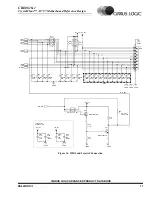
2
DS241RD1C1
CRD4610-1
CrystalClear™ AC '97 Motherboard Reference Design
CIRRUS LOGIC ADVANCED PRODUCT DATABOOK
GENERAL INFORMATION
Today’s multimedia applications demand high
quality PC audio and many audio connections. To
meet this demand Intel
®
defined the AC ‘97 (Audio
Codec ‘97) specification that defines a two chip au-
dio solution [1]. The idea behind the two-chip solu-
tion is to have a separate audio controller chip
connected to the PCI bus to accelerate increasingly
popular audio processing functions such as Aureal
A3D
TM
, DirectSound 3D
TM
, wavetable synthesis,
and Dolby
®
Digital (AC-3
®
) decoding. A separate
audio codec is connected to the controller for ana-
log mixing and data conversion. Audio data is
transferred between the controller chip and the au-
dio codec through a standard digital interface
called an AC Link at a 48 kHz frame rate. For more
information on AC ‘97 and the AC Link, please
consult the AC ‘97 specification [1].
The advantage of a two chip audio solution is that
the analog section of a system can be completely
separated from the noisy digital environment of a
personal computer. A digital link is all that is re-
quired to connect the audio codec to the PCI bus-
based AC’97 controller. This allows the audio sec-
tion to reach the required signal to noise ratio of
~90 dB while making the layout and placement of
the audio section easier to implement.
The CRD4610-1 demonstrates Cirrus’ two-chip so-
lution using the CS4610 SoundFusion PCI Audio
Accelerator and the CS4297 SoundFusion Audio
Codec. These two integrated circuits demonstrate
Cirrus’ powerful DSP controller and unsurpassed
CrystalClear audio quality in a single PCI add-in
card reference design.
REFERENCE DESIGN FEATURES
The reference design illustrates a typical four-lay-
er, single sided motherboard layout. The reference
design card is sectioned into three main parts: the
CS4610 PCI Audio Accelerator section, the
CS4297 Audio Codec ‘97 section, and the Optional
Extended Analog I/O section.
CS4610 PCI Audio Accelerator Section
The area around the CS4610 includes the required
bypass capacitors, PLL power supply filter compo-
nents, an EEPROM, the components for the joy-
stick connection and a buffer circuit for the external
MIDI connection. The layout of this section com-
plies with the PCI specification version 2.1 [2] for
add-in cards. Please refer to the Schematic and
Layout sections of this document for more infor-
mation. For more information on the CS4610, refer
to the CS4610 Data Sheet [3]. The required area for
this particular layout is 1.97 sq. in.
External EEPROM
The CS4610 EEPROM contains the required Sub-
system Vendor ID and Subsystem ID values as well
as two configuration registers which configure the
software driver of the CS4610 to operate in AC ‘97
link mode. The CS4610 currently requires 7 data
bytes in the EEPROM for configuration. The PCI
Special Interest Group assigns manufacturers a
Subsystem Vendor ID. To meet WHQL
™
stan-
dards, the Subsystem ID must be a non-zero value.
Please call Cirrus Logic PC Products Crystal Audio
Division at (512) 445-7222 to have a Subsystem ID
assigned to a particular project.
If the CS4610 is implemented on a mother board,
an external EEPROM is not required for proper op-
eration. A host-load procedure may be used for
configuration in this case. However, silicon revi-
sions rev. C and prior must use an EEPROM if a
unique Subsystem ID is required. This is due to an
errata which causes the upper byte of the subsystem
vendor ID to be duplicated in the subsystem ID
field during host load to the SSVID register.
It is recommended that an EEPROM be used dur-
ing system development to allow debug and con-
figuration changes without having to modify BIOS
code. If host load will be used in production, the
EEPROM circuitry can be left unpopulated.
Содержание CRD4610-1
Страница 30: ......

















